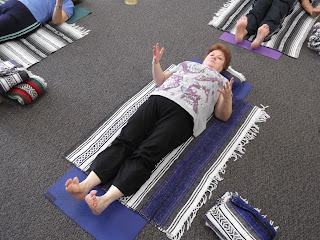I hope you all had a wonderful Thanksgiving! We all have so much to be thankful for.
I thought we'd talk about AHIMSA today, one of several ethical disciplines which are the root teachings of yoga. These disciplines are likened to the roots of a great tree. The roots support a tree and provide it with nourishment, strength, and stability. The first of the "eight limbs of yoga" are the ethical disciplines. These precepts are called YAMA. They are the great commandments which transcend creed, country, age, and time; the rules of morality for societies and individuals. The basic truth teachings of all truly spiritual practices.
 |
| The Angel Tree near Charleston, South Carolina |
The word AHIMSA means non-harming, non-killing, or non-violence. It has a wider meaning, requesting us to love. It's helpful to understand that violence is a state of mind, not of diet. Therefore, one can be a vegetarian (non-harming of animals), but still be a person with a violent temperament (harming in thoughts, words, or actions).
First, ahimsa must be applied to our thoughts. Our thoughts are the subtlest of forms. Thoughts can then manifest into speech and/or actions. We can control our thoughts. First, we need to be aware of what we are thinking. Then we can change our thought patterns if we observe them becoming hurtful, viscious, or violent.
We all know how it feels when someone has spoken unjustly or harshly to us. It feels like arrows into our hearts. Sometimes we don't think what we say is really going to hurt anyone, but this is so incorrect! Hurtful speech rips our auras and unbalances our psyches. Sometimes we react with anger and viciousness by verbally lashing back. Let us think before we speak. Let's speak kindly or not at all.
Our actions appear to be the most obvious form of violence. Think about it, though. If we didn't have a hurtful thoughts, harmful and violent speech or actions would never be a problem. We have to start at the root of the action, which is our thoughts.
Violence arises when we succumb to fear, when we are weak or ignorant, or when we become restless. To curb our violent tendencies we need to be free from fear. We must change our outlook on life, change our attitude. We need to re-orient our minds. There are several powerful yoga practices which will accomplish this change. How do we make our fears subside? I suggest two ways here.
For the first suggestion, let's refer back to an earlier post on FEAR CAN CRIPPLE YOU Oct. 17, 2012. In this discussion I recommended meditation. Meditation is a practice that interrupts our current state of mind. When we practice, we stop, sit, and consciously take time to be still. The physical actions of stilling the body and slowing the breath immediately begin the process of stilling the mind. Meditation is a powerful and immediate intervention which will help us on all levels. Continued practice will give us clarity, focus, serenity, and freedom from fear.
The second practice I suggest is called ISVARA PRANIDHANA. This is dedicating our actions and will to the Lord. It doesn't matter what religion we are, as long as we are aware that there is a power greater than ourselves. My very first yoga teacher taught me that this surrendering is vitally important. We dedicate our life, (body, mind and spirit) and actions to the Lord. After all other efforts and resources have been exhausted, if we still have not succeeded, we turn to the Lord. "Let go and let God" - one of my pastors used to say this over and over. When we do this, the mind, intellect, and will have surrendered to the highest power. "The name of the Lord is like the Sun, dispelling all darkness". (Iyengar, Light on Yoga)
Freedom from fear comes to those who live a pure life. The body itself may be subject to age, decay, sickness, and death, but our spirit remains pure and unaffected. When we have linked our entire being-ness to the Divine, what is there to fear? How can we be harmful towards others when we are secure in the knowledge that our spirit is deathless?
As yogis, let's be an example to others. Show compassion towards all living beings. Let's be happy for others' accomplishments. Show gratitude for and appreciate all we have. Everyone and all other life forms and creatures have a right to be alive. When we practice ahimsa we begin to realise we are born to serve others. What greater legacy can we leave?
If you have any questions related to this post or any other questions, please don't hesitate to ask. I'm happy to help answer your questions or reply to your comments. Namaste!











